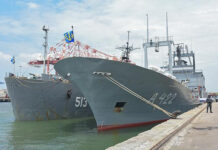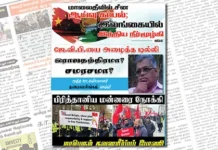Could China’s reluctance to provide assistance to Sri Lanka during its financial crisis be part of a strategy to keep the country rocky and keep India distracted and engaged on multiple fronts? Suren Surendiran explains in an article published in The Wire.
In the past decade, China has been the largest foreign investor in and the second-largest foreign lender to Sri Lanka.
In the past 24 months, China, surpassing India, has become Sri Lanka’s top import partner(in 2020, Sri Lanka imported $3.58 billion worth of goods and services from China compared to $3.01 billion from India). Nevertheless, Sri Lanka exported $654.44 million worth of goods and services to India, compared to only $252 million to China.
In every financial measure, China has the upper hand in Sri Lanka compared to India. What’s more, China provides blanket support to Sri Lanka in international forums such as the United Nations and its bodies, particularly in the Security Council and Human Rights Council (UNHRC).
India, on the other hand, has to carefully balance its position at these forums due to its historic involvement in Sri Lanka’s internal conflicts and the large constituency of Tamil Nadu.
In the past decade and a half, Chinese engagement with India’s neighbours has increased manifold. China uses various financial and non-financial instruments to facilitate this engagement. The Belt and Road Initiative (BRI) is one major vehicle for doing so.
In terms of foreign direct investment (FDI), trading partnerships, using its lending capacity to finance major infrastructure projects, military assistance and, in some instances, providing diplomatic cover at international forums, China either leads or is among the top five countries when it comes to the majority of India’s neighbours.
Also read: Sri Lanka, India and China: Here’s What Keeps Neighbours Friendly – and What Doesn’t
While the intentions behind each vary, the primary strategic interest is regional domination and tacit intimidation.
Chinese strategic interests in Sri Lanka, as with the rest of India’s neighbours, may have many dimensions. However, the approach, when it comes to Sri Lanka, seems different. For example;
- China has given duty-free (DF) access to 97% of Bangladeshi products, which came into force from July 1, 2020. However, with Sri Lanka, China doesn’t even have a free trade agreement (FTA).
- In June, 2020, China agreed to delay debt repayments from Maldives. However, despite being the largest foreign lender to Sri Lanka, no such favourable terms, even to provide some breathing room, have been granted to Sri Lanka.
- Chinese assistance to Nepal falls into three categories: Grants (aid gratis), interest free loans and concessional loans. Sri Lanka, on the other hand, owes China over $6 billion, all in interest-bearing loans of some kind. Only recently was a grant of $90 million given to Sri Lanka after a delegation from Beijing visited Columbo in October, 2020.
If China offered any of these measures (or a combination of them) to Sri Lanka, it would give the latter a chance to recover from its financial and economic woes.
This differential treatment could, perhaps, have been conceived to keep sufficient control over Sri Lanka while maintaining instability within it in order to keep India distracted and engaged on multiple fronts; a sustainable way of maintaining instability is to create a weaker Sri Lankan economy.
The Sri Lankan economic crisis
“Our country is facing a severe foreign exchange crisis. Data from the Central Bank shows that the country’s net foreign exchange reserves are close to zero, which means almost all of its reserves are borrowed.” This statement, made by Sri Lanka’s finance minister Basil Rajapaksa to Parliament on September 7, exemplifies the dire situation of the Sri Lankan economy.
On July 19, days before the Sri Lankan government was due to settle a sovereign bond of $1 billion, the global ratings agency, Moody’s, placed the government’s ’Caa1’ foreign currency long-term issuer and senior unsecured debt ratings under review for downgrade. This immediately triggered a frenzy of panic selloffs at huge discounts.
Also read: Sri Lanka Declares Food Emergency as Country Runs Out of Forex Reserves to Finance Imports
This was the second time in less than six months that Moody’s had provided a negative assessment of Sri Lanka’s economic conditions. Only a few months prior, Fitch Ratings had downgraded Sri Lanka to its CCC category, indicating a real possibility of default.
In a recent report, Bloombergstated that “Sri Lanka’s risk premium for a default jumped, reflecting concern that the pandemic is damaging the nation’s ability to fill its foreign-exchange coffers.”
Early in August, the one-year default probability was at 27.9%, the steepest in Asia, up from around 13% six months prior. according to a Bloomberg model. In this model, a reading above 1.5% signifies a high risk of failure to pay.
These negative indicators and rating agencies’ negative coverage destroy investor confidence, phenomenally increase borrowing costs and shut Sri Lanka off from international capital markets.
Sri Lanka’s ministry of finance reacted immediately to Moody’s making the announcement with a statement titled, ‘Statement by Moody’s Investors Service is ill-timed, ill-judged and hence unacceptable’.
One senior diplomat based in Colombo had said, “…[W]hen you are sparring with the rating agencies, you have got problems”. Another commented saying, “…[T]he whole concept of independent international rating agencies are there to do exactly this…to advise investors, portfolio managers, agencies and institutions in a timely and accurate fashion”
The country’s foreign currency reserves stood at $2.8 billion at the end of July and at $3.55 billion at the end of August.
Last month, Ajith Nivard Cabraal, then state minister of finance and current governor of Sri Lanka’s central bank, listed potential inflows over the next three months, which would amount to nearly $2.65 billion:
- Swap with India: $400 million
- Swap with Bangladesh: $250 million
- Loan from China Development Bank: $300 million
- Special Drawing Rights allocation from the IMF: $800 million
- Central Bank purchases from the Forex market in the next three months: $200 million
- Inflow from ISBs held by local banks: $ 300 million
- Expected inflows from the utilisation of under-utilised assets: $ 400 million
The Central Bank has also negotiated a swap with the People’s Bank of China for a sum of $1.5 billion, which too, can be accessed and hence could be included as a part of its effective reserves, Cabraal added.
The majority of these are interest-bearing loans of some form. It cannot be assumed that some or all of these loans could be rolled over without certain conditions.
For example, the $400 million from India cannot be rolled-over more than once without the Sri Lankan government signing an agreement with the IMF. Sri Lanka, at least for now, vehemently rejects such a proposition.
In January this year, the government was of the firm belief that export incomes would compensate for some of the depreciating reserves. Unfortunately, Sri Lanka’s economic growth recorded its worst performance in post-independence history with a 3.6% contraction while the budget deficit hit its lowest level in 38 years.
In 2020, exports of goods fell 15.6% from $12 billion in 2019 to $10 billion. Exports of services fell roughly 60% from $7.5 billion to $3 billion. Exports of goods improved in the first half of 2021, yet remained 7% lower than at the same time in 2019, before the pandemic. Exports of services haven’t recovered significantly since the fall in 2020.
These weak economic indicators have led to a near 10% depreciation of the Sri Lankan rupee against the US dollar over the past one year, making imports more expensive.
President Gotabaya Rajapaksa declared a state of emergency on August 31 to deal with food shortages, as most banks have run out of dollars to finance imports.
Sri Lanka has to repay about $2 billion in foreign debts before the end of the year.
The question which comes to the fore amidst all these developments is: has China succeeded in creating and maintaining an unstable Sri Lanka, just 22 miles off India’s shores?
Published in The Wire
Suren Surendiran, an accountant by profession, is director of strategic initiatives and spokesperson for Global Tamil Forum.





